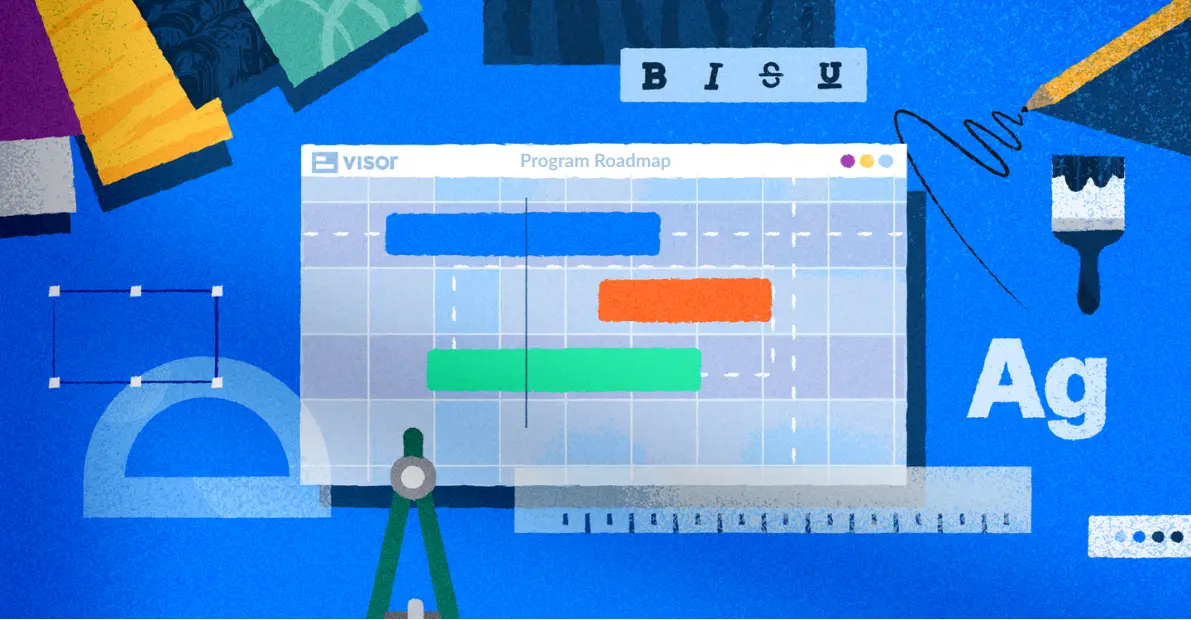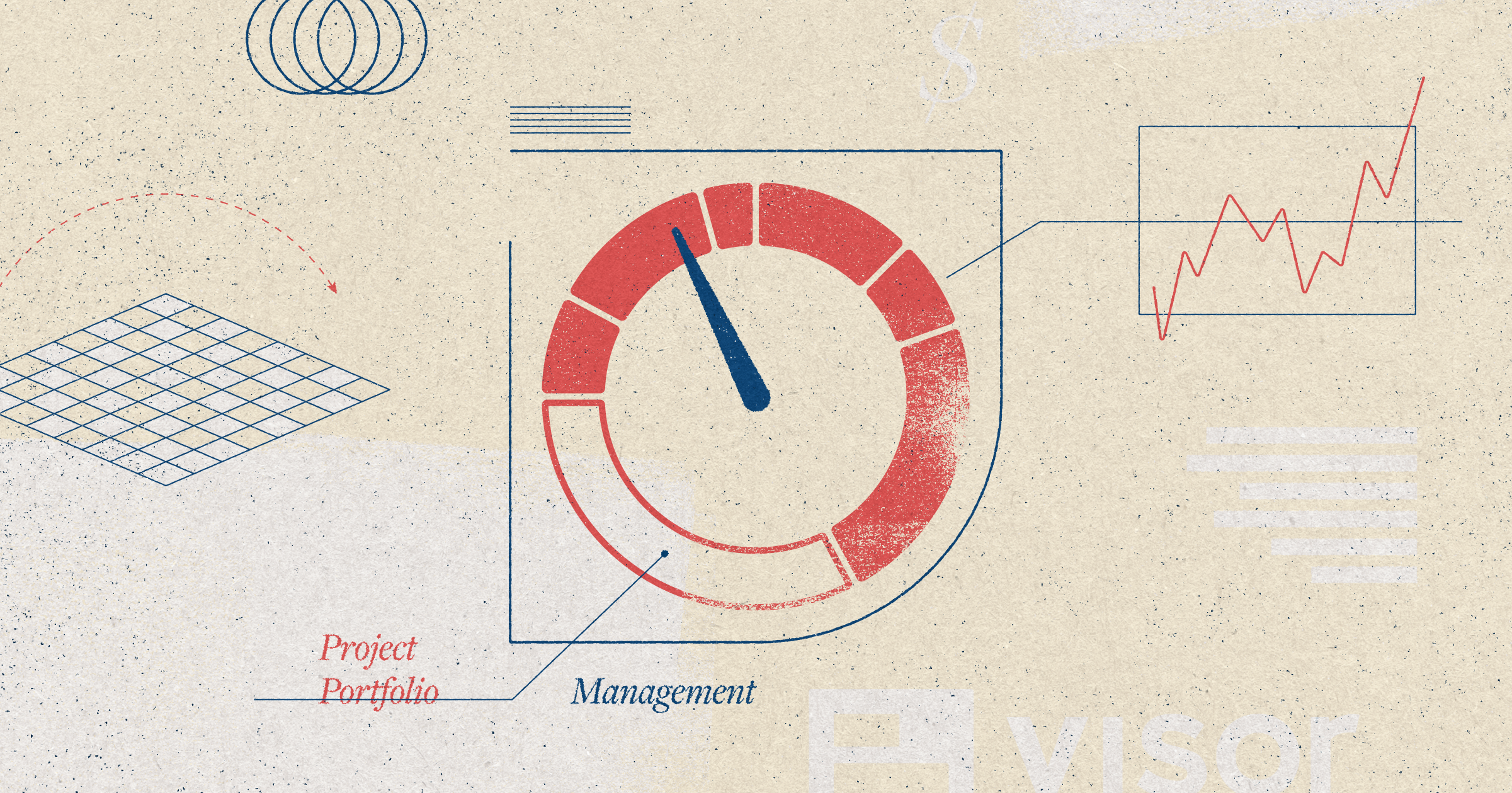
Project Portfolio Management: Your Complete Guide
Project portfolio management (or PPM) is a powerful capability you can use to improve your organization’s overall management of projects. It can also help you improve your projects’ strategic alignment, performance, and to achieve strategic goals.
There is a lot of confusion around what project portfolio management really means, who should do PPM, and perhaps most importantly, the correct processes, practices, and approaches for successful PPM.
In this guide I’ll resolve that confusion for you. First, you’ll get all the core foundational knowledge you need to understand what PPM is, why organizations do it, and whether you should do it, too.
Then, I’ll give you some fast takeaways on PPM best practice that you can easily put into action, with a framework to design an iron-clad PPM process, so that you can start benefiting from project portfolio management right away.
If you need a tool to help you manage portfolios of projects, then you should try Visor for free.
Visor is an easy to use, highly flexible PPM tool that is both powerful and user-friendly. Unlike many other PPM systems, Visor is used by teams and organizations of all sizes, from smaller startups to large multi-matrixed organizations.
A PPM Gantt chart showing multiple projects on a roadmap. I created this in Visor using real-time data from Asana and Salesforce:
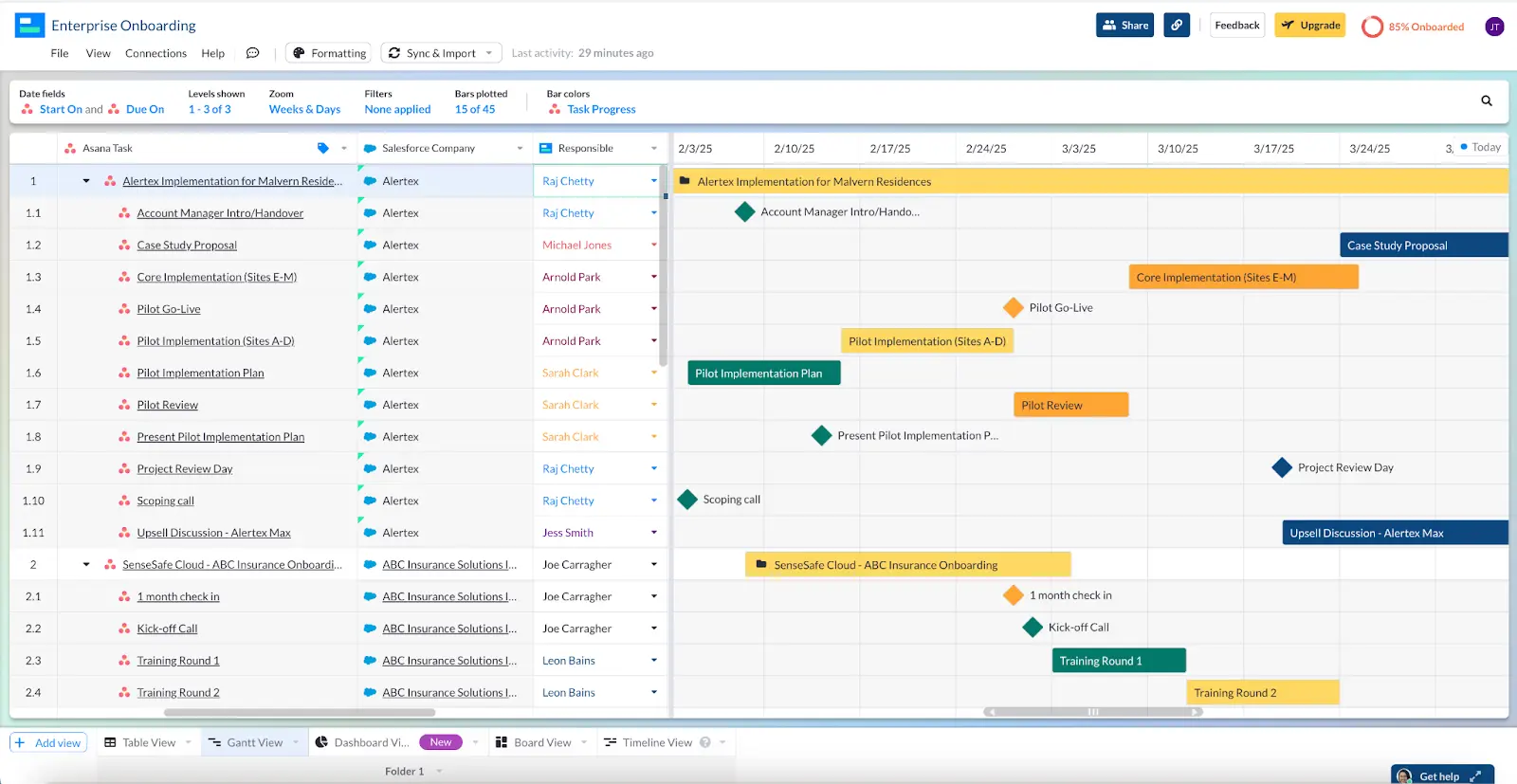
What is Project Portfolio Management?
Project portfolio management (or PPM) is the management or oversight over a group of projects. The group of projects is the portfolio of projects.
Often, the project portfolio includes all of the organization’s projects, but sometimes, organizations split projects into separate portfolios.
You’ll usually find multiple project portfolios are when an organization is very large, and separate portfolios are created based on criteria such as business unit, strategic goal, or project size/complexity.
Grouping projects into portfolios enables organizations to take a collective view of their projects and to understand and manage project performance, resource requirements, and project scheduling.
Some organizations have a specific, centralized project portfolio management function which is responsible for the selection, prioritization, and monitoring of all that organization’s projects.
What is a Portfolio In Project Management?
A portfolio in project management is a collection of individual projects, groups of projects organized into programs, and other project-adjacent activities.
The diagram below illustrates an example of a basic project portfolio and the different elements that are part of that portfolio:

Here is a diagram showing a more complex example of a portfolio in project management, which includes a sub-portfolio, multiple programs, and projects:
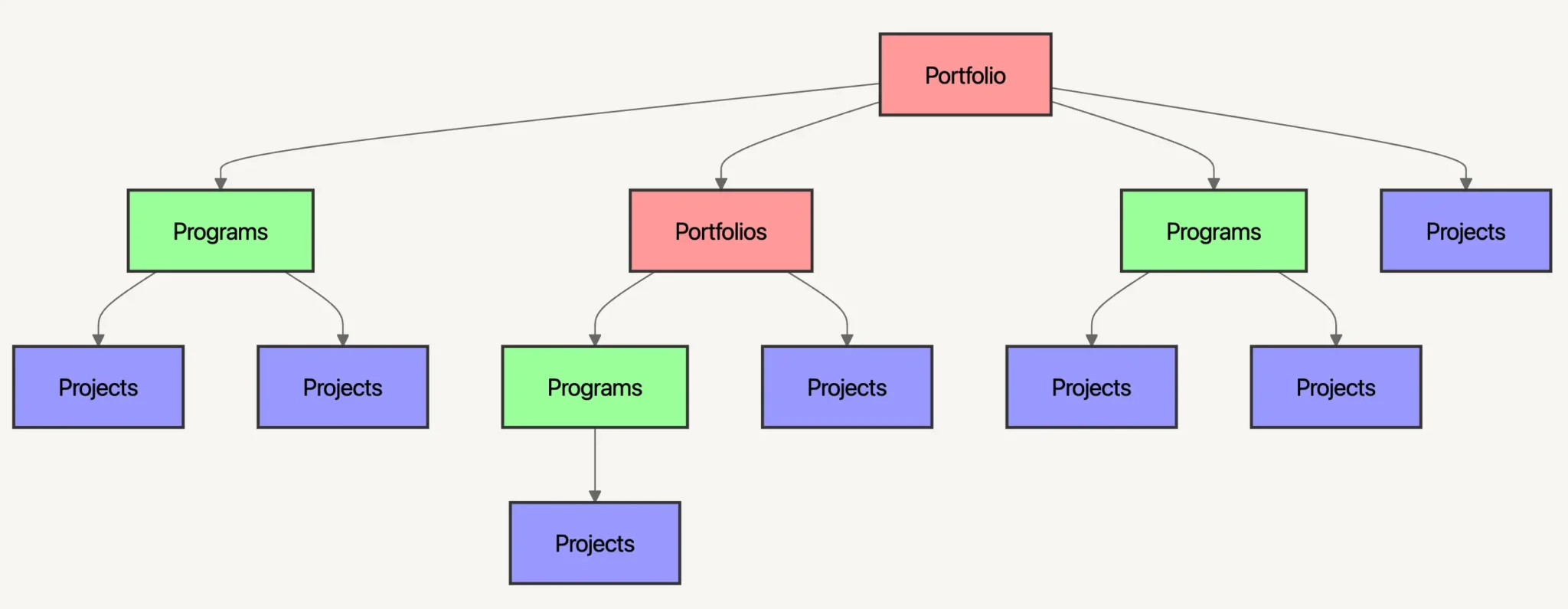
Grouping projects and programs in a portfolio enables project portfolio managers to track and improve the performance of the portfolio as a whole, which is typically assessed for overall ROI and the achievement of strategic organizational goals.
Some project portfolios also include sub-portfolios, which are smaller portfolios containing collections of projects and programs. There’s more detail on this in the section below.
Can You Create Multiple Project Portfolios?
Yes, many organizations decide to create multiple project portfolios, typically for different business units or strategic objectives. You can even create sub-portfolios of portfolios.
Effective management of multiple project portfolios requires the following:
- Documented selection criteria, prioritization processes, and approval workflows (typically uniform across all portfolios)
- A collaborative and coordinated approach between portfolio managers (rather than a competitive one)
- Uniformity of metrics and measurements
- Coordination across portfolios to take advantage of opportunities to streamline resources
- Regular review meetings
- Use of the same systems (i.e., PPM software) across portfolios/by portfolio managers
- Clear (and continuously improving process) for segmenting projects into the correct portfolio
- Regular review meetings for portfolios individually and as a whole
Sticking to these guidelines prevents divergence of processes between different portfolios of projects. It also maximizes the opportunities for shared learning between portfolio managers, and continuous improvement of your overall portfolio management frameworks and processes.
Why Do Organizations Do Project Portfolio Management?
The goals of project portfolio management can vary between different organizations, but will typically focus on:
- Balancing resources and capacity across projects
- Managing and mitigating risks
- Maximizing project ROI
- Understanding and managing cross-project dependencies
- Ensuring projects align with strategic objectives
- Selecting the right projects to help you achieve your strategic goals most efficiently and effectively
In theory, project portfolio management has clearly defined attributes and processes. Still, in the real world, people and organizations do project portfolio management differently depending on their organization’s size, requirements, and business context.
Portfolio Management vs Project Management
Understanding the differences between project portfolio management and project management is important.
Project management refers to the planning, management, and execution of a single project. A project delivers a specific product, service, or change. Most projects have clearly defined start and end points.
Project portfolio management is the management of multiple projects and programs to achieve overarching organizational objectives.
Project portfolio management involves selecting which projects an organization should pursue, the allocation of resources across projects, and ensuring that all projects are aligned with and successfully contribute to the achievement of those organizational goals.
Unlike managing a project, managing a portfolio never ends, as new projects and programs are selected and added to the portfolio over time.
Project vs Program vs Portfolio Management
Program management sits somewhere between project management and portfolio management. Program management is the process of overseeing a set of closely related, and often interdependent projects so that all are completed successfully.
Simple diagram showing the hierarchy of organizational goals/objectives and mission, through PPM and program management, down to project and task management:
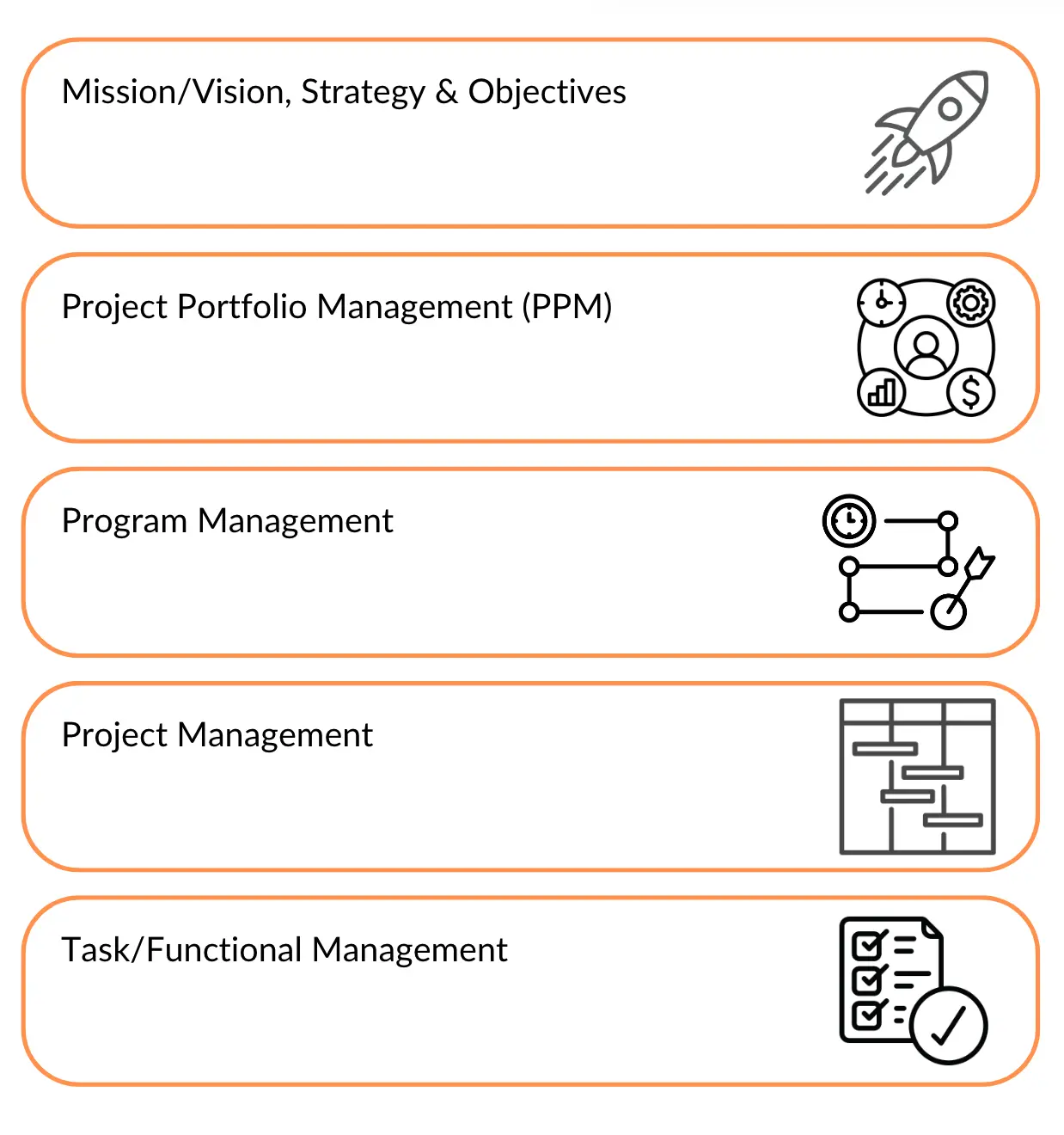
What is project management?
- The management of a single projects in siloes
- Manages the resources allocated to each project individually
- Uses detailed schedules, plans, and task/project management tools
- Success means delivering each individual project on time, to budget, and to specification
What is program management?
- Overseeing closely related projects grouped into a “program”
- Manages resources (including competition for resources) across projects in the program
- Uses high-level planning tools with a focus on resource utilization, resource requirements, and cross-project dependencies
- Success means the completion of all projects in the program
What is portfolio management?
- Evaluate and select projects and programs based on their alignment with strategic goals and expected ROI
- Establishes, prioritizes, and allocates resources across the entire portfolio
- Use project portfolio management (PPM) systems, prioritization frameworks, capacity planning tools, and reports that aggregate performance data across the project portfolio
- Success means the aggregate ROI overperformance of the portfolio, rather than any single project or program, and achievement of organizational strategic goals
Are project, program, and portfolio management always clearly delineated?
Within large organizations, project management, program management, and portfolio management can be clearly delineated into separate roles and responsibilities.
At smaller and mid-sized organizations you will typically find overlap between these three areas, and the approach to portfolio management will usually be much less developed and more focused on managing and monitoring projects, as opposed to running project intakes and selection.
However, this is usually not a shortcoming, as many of the more complex aspects of project portfolio management would be very out of place in smaller organizations where decision making is more fluid.
Adding overly complex PPM processes to small and mid-sized organizations can restrict their agility and place unnecessary burdens on their time and resources.
What Does Project Portfolio Management Mean In Different Contexts?
Complex project selection and monitoring processes may seem a bit alien or more elaborate than examples of project portfolio management you recognize from your own experience. You’re right to feel that way.
The nature of project portfolio management can vary greatly depending on the size and structure of an organization, from more basic to complex (full scale) forms.
Neither is better than another. Some organizations are large and complex enough that they require the level of oversight that a centralized, full scale/highly developed project portfolio management.
Basic Project Portfolio Management
Sometimes you don’t need to go all in and try to implement an advanced project portfolio management process. You may even be doing a form of project portfolio management already and not realize it.
For example, in smaller organizations, project portfolio management may simply mean implementing high-level reporting views and processes, which provide a collective, bird’s eye view of all the organization’s projects.
This collective, high-level view of projects enables leadership to measure and understand the performance of all their projects and identify weak points, risks, or opportunities to optimize performance, or reallocate/rebalance resources.
At its most basic, project portfolio management can simply mean creating a table view or Gantt chart that incorporates all your team’s or organization’s projects.
Here’s an example of a table view I created in Visor that combines information from all projects in my portfolio (using real-time data from Jira):
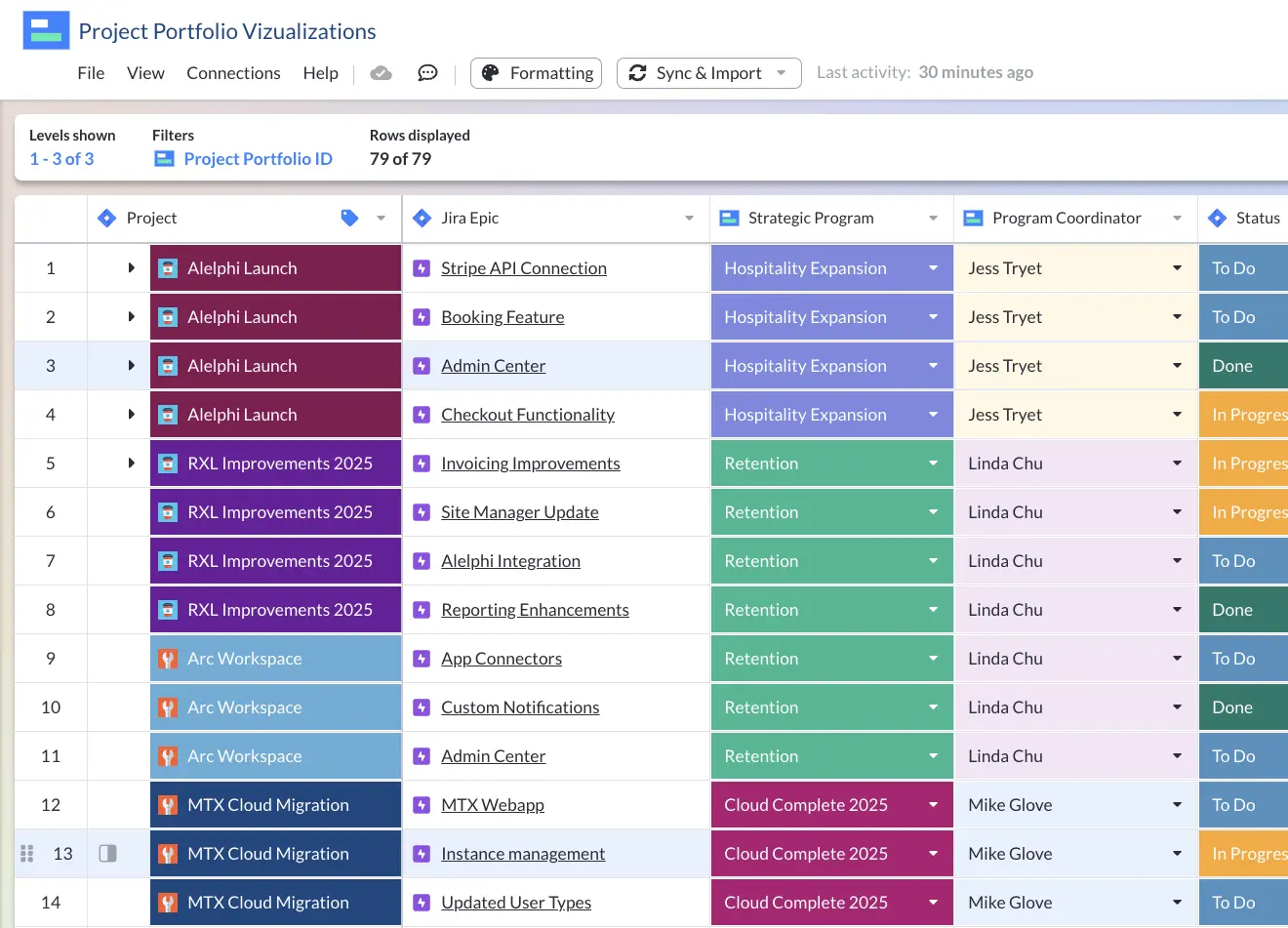
Here’s a Gantt chart I created in Visor that tracks all epics from the Jira projects in my portfolio, it’s great for giving my CEO an overview of our plans:
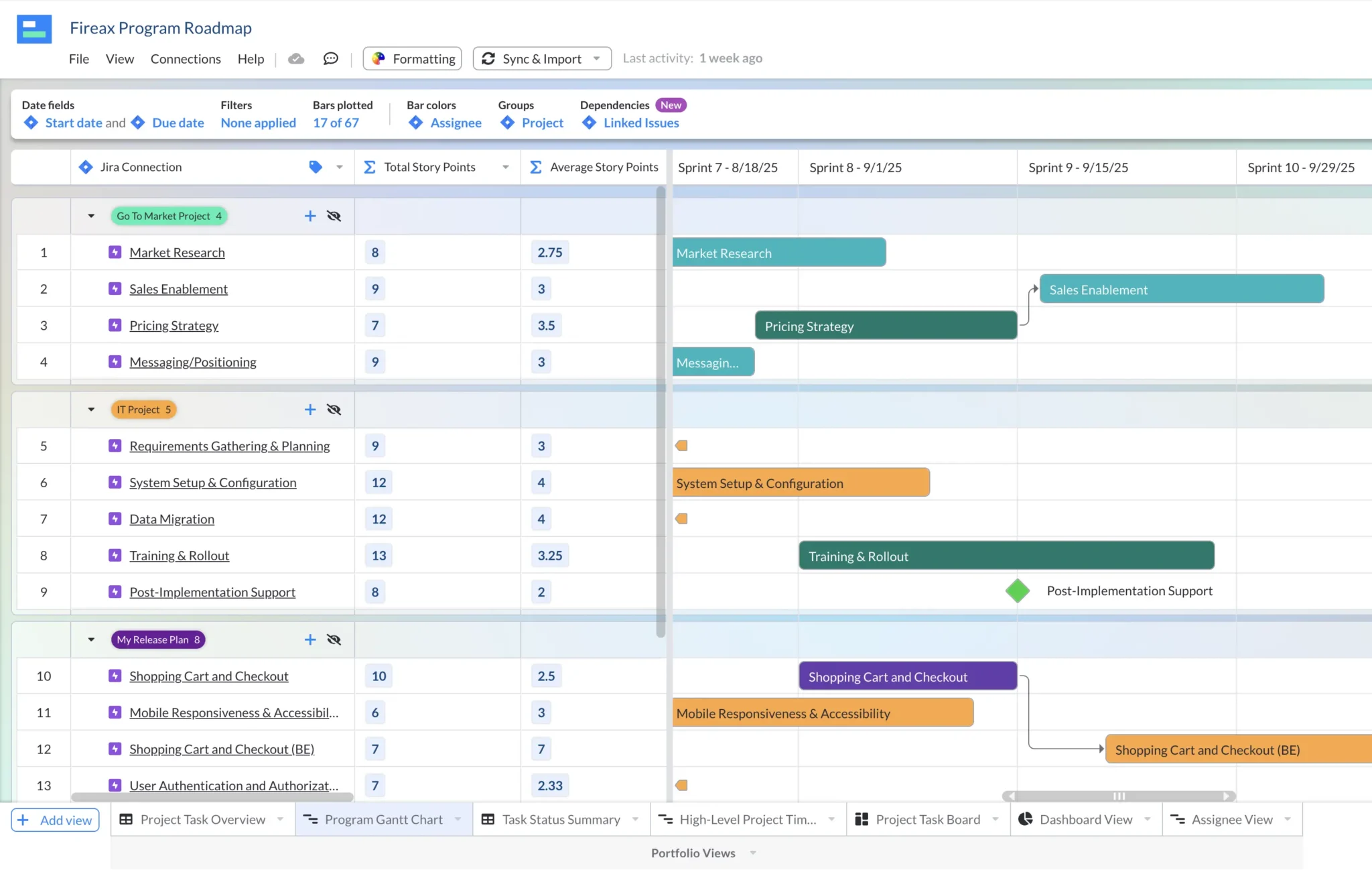
Whether you’re doing more basic or advanced versions of PPM, or even agile project portfolio management, you’ll always need visualizations like these, and dashboards that give you real-time performance insights for your entire portfolio, and project-to-project comparisons of performance too.
Here’s a project portfolio reporting dashboard created in Visor’s dashboard view:
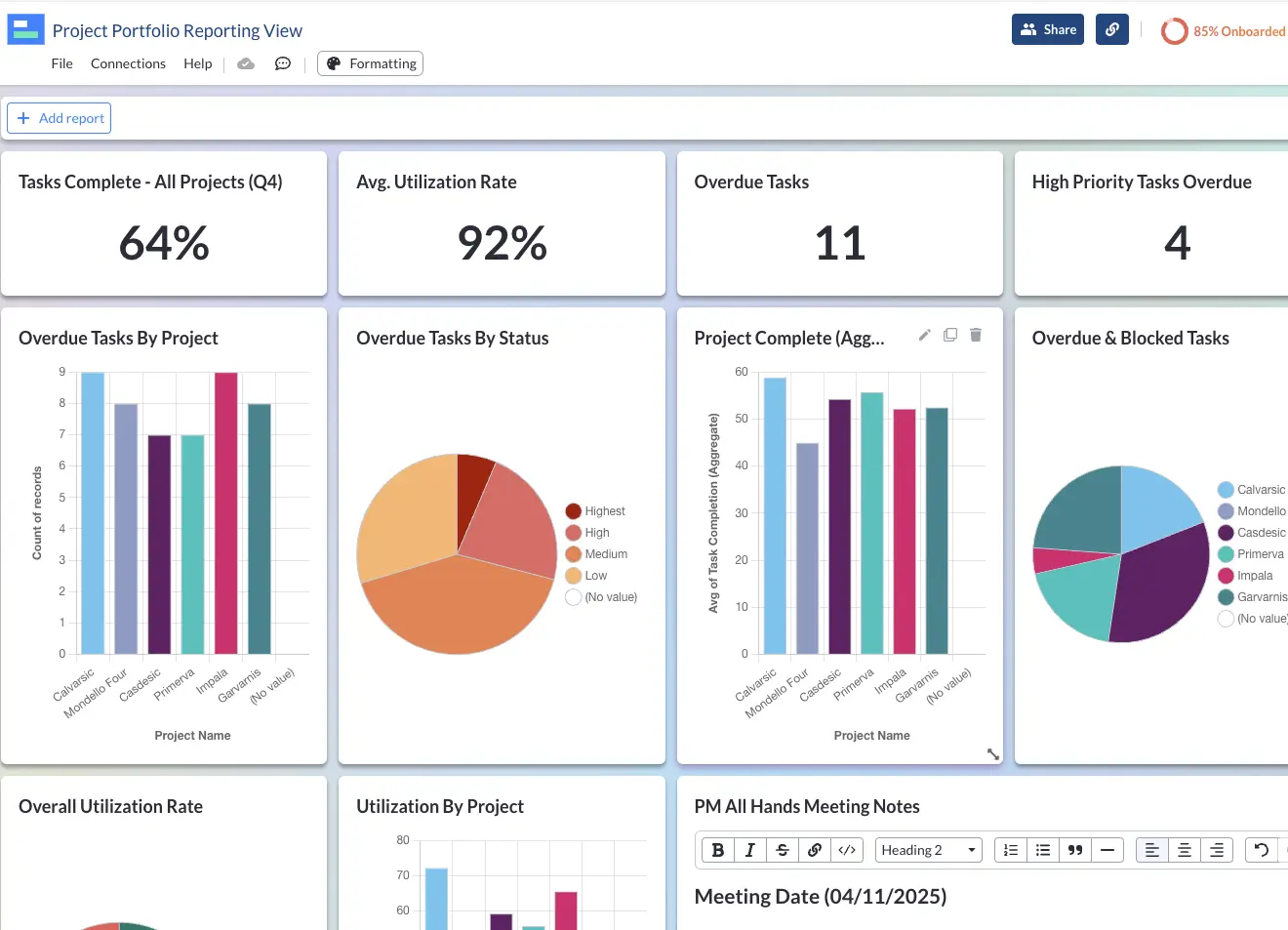
Here’s another example of a project portfolio dashboard created in Visor:
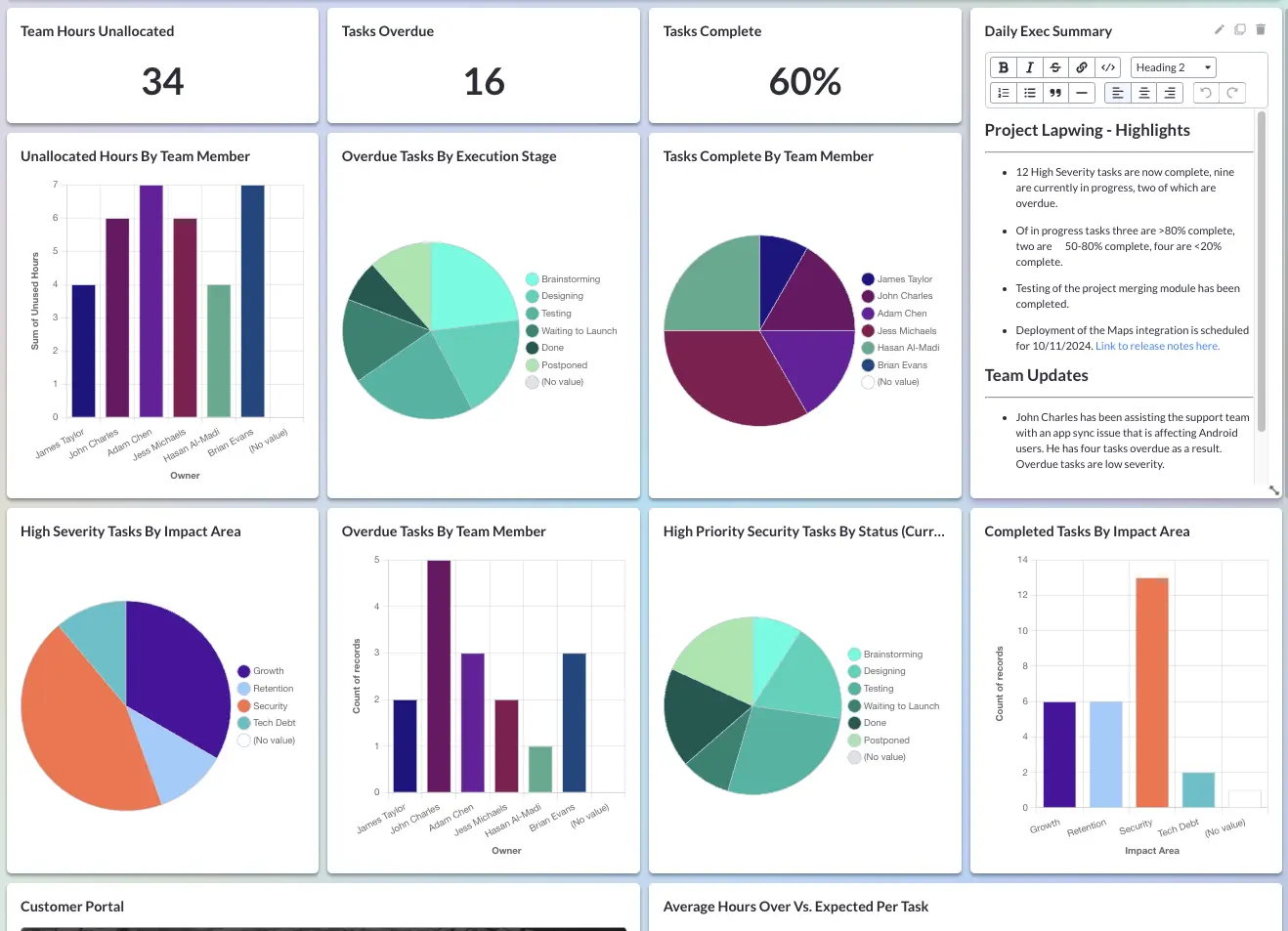
Project portfolio management should only ever be as developed or complex as is needed to help your organization meet its strategic goals more efficiently. Adding complex PPM processes or personnel just to feel like you are doing “real” PPM is not a worthwhile investment of your time or resources.
Full-Scale Project Portfolio Management
In organizations with a fully developed project portfolio management function, PPM extends much further into processes that happen before and after a project starts and ends. It also involves more aggregated reporting and focus on the value or ROI that the project portfolio delivers.
Full-scale, or fully developed project portfolio management has more structured, formal workflows and processes, with clearly defined rules about how each part of the process should run and how the portfolio should be managed and overseen.
Full-scale PPM processes determine:
- Which projects should be selected and added to the portfolio
- The prioritization of projects
- The scheduling of projects
- Level of resources that will be dedicated to them
- How projects’ performance is monitored and assessed
The project portfolio manager will then use ongoing reporting and monitoring to ensure projects perform well and stay aligned with strategic objectives.
Before: Project Selection
First, newly proposed projects are subject to an evaluation, selection, and prioritization process based on whether they:
- Align with the organization’s strategy
- Can be delivered with the organization’s resources
- Align with the organization’s capabilities
- Will deliver a justifiable return on investment
- Have feasible plans (can be delivered within the planned timeframe and budget)
- Carry any significant risks to success and if these can be mitigated
Projects that pass this selection process are added to a project portfolio, scheduled, and assigned to a project manager.
During/After: Project and Portfolio Monitoring
Once the project starts, you can measure its performance continuously using project portfolio management metrics, including:
- On-time delivery: How closely are tasks being completed to planned deadlines
- Schedule variance: How far is the project’s actual timeline deviating from its planned timeline
- Return on investment (ROI): The total return of a project, minus the cost, divided by the cost or investment: ROI = (return – investment)/investment
- Budget variance: The difference between planned and actual project spend
- Resource utilization: The extent to which resources (typically project team member hours) are being over or under-utilized, often expressed as a percentage
Actively monitoring portfolio management metrics like these enables you to assess performance by project, make comparisons between projects, and identify which projects are outliers from the average for any particular metric.
All of this can help you identify areas of high and low performance so that you can make sensible interventions to improve the performance of individual projects and your portfolio as a whole.
Who Is Responsible For Project Portfolio Management?
In larger organizations you’ll find specialized project portfolio managers or portfolio managers.
It’s their job to design and implement comprehensive project portfolio management processes, and to make the calls about which projects the organization’s resources should be put behind.
However, lots of people who aren’t officially project portfolio managers perform a range of portfolio management tasks, and may not even be aware these tasks are technically part of PPM.
This is especially true of project managers who work in smaller organizations, where they will need to:
- Align projects with organizational goals
- Manage and allocate resources across projects
- Track performance across projects
- Select and prioritize projects based on a range of criteria (including capabilities, strategic alignment, budget, resources, and so on)
If you asked them, these project managers may not identify these responsibilities as part of PPM, but they clearly match up with the role a project portfolio manager plays in an organization. Carrying out these responsibilities effectively will also require some form of PPM software too.
Project Portfolio Management (PPM) Software
Most people doing project portfolio management use some type of PPM tool, even those doing relatively basic forms of portfolio management, or managing quite small portfolios.
This is because project portfolio management involves a large number of moving parts, complex planning, and aggregating data for reporting. Without the help of PPM software these processes are extremely time consuming, inefficient, and error prone.
However, a common complaint is that most PPM software is old fashioned, complex, and difficult to use. Pricing is also a major barrier, with most PPM software being targeted at large enterprises and only affordable to them.
Visor is very different. It is a modern, easy to use, PPM tool that integrates with apps like Jira, Asana, and Salesforce, so you can create real-time portfolio-level capacity plans, portfolio roadmaps, dashboards, and other visualizations, which you can share with your stakeholders too.
Visor is suitable for teams of all sizes and all budgets. You can use a free trial of Visor to see if it is the best PPM tool for you. Or if you want to do more research first you can compare different PPM software in our roundup of the best PPM software right now.
A Program Roadmap in a Visor Gantt chart, grouped by projects, with rollup calculations for Total Story Points and Average Story Points:
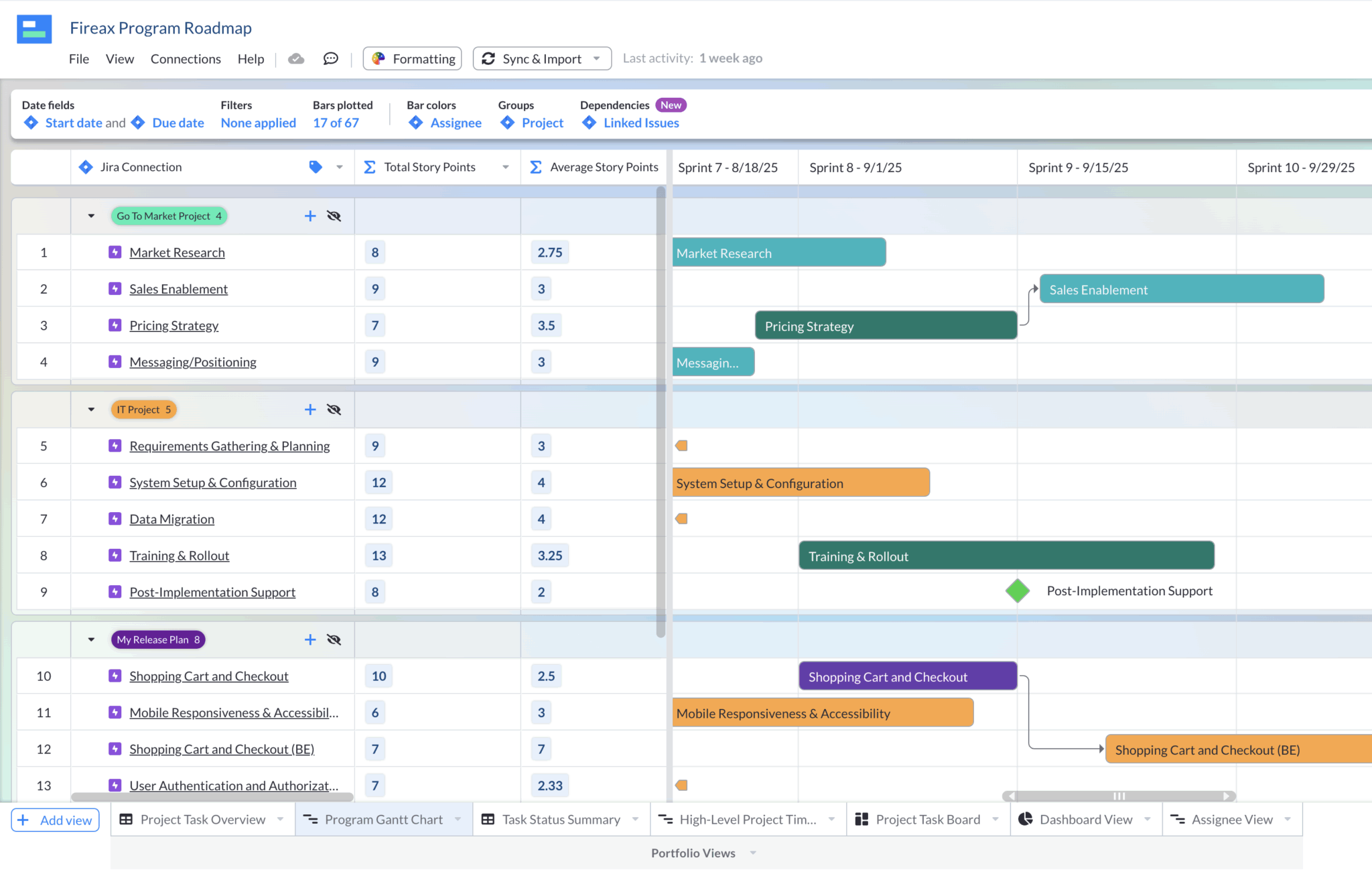
A Portfolio Gantt Chart in Visor, with projects grouped by Project Manager, note the cross-project dependencies:
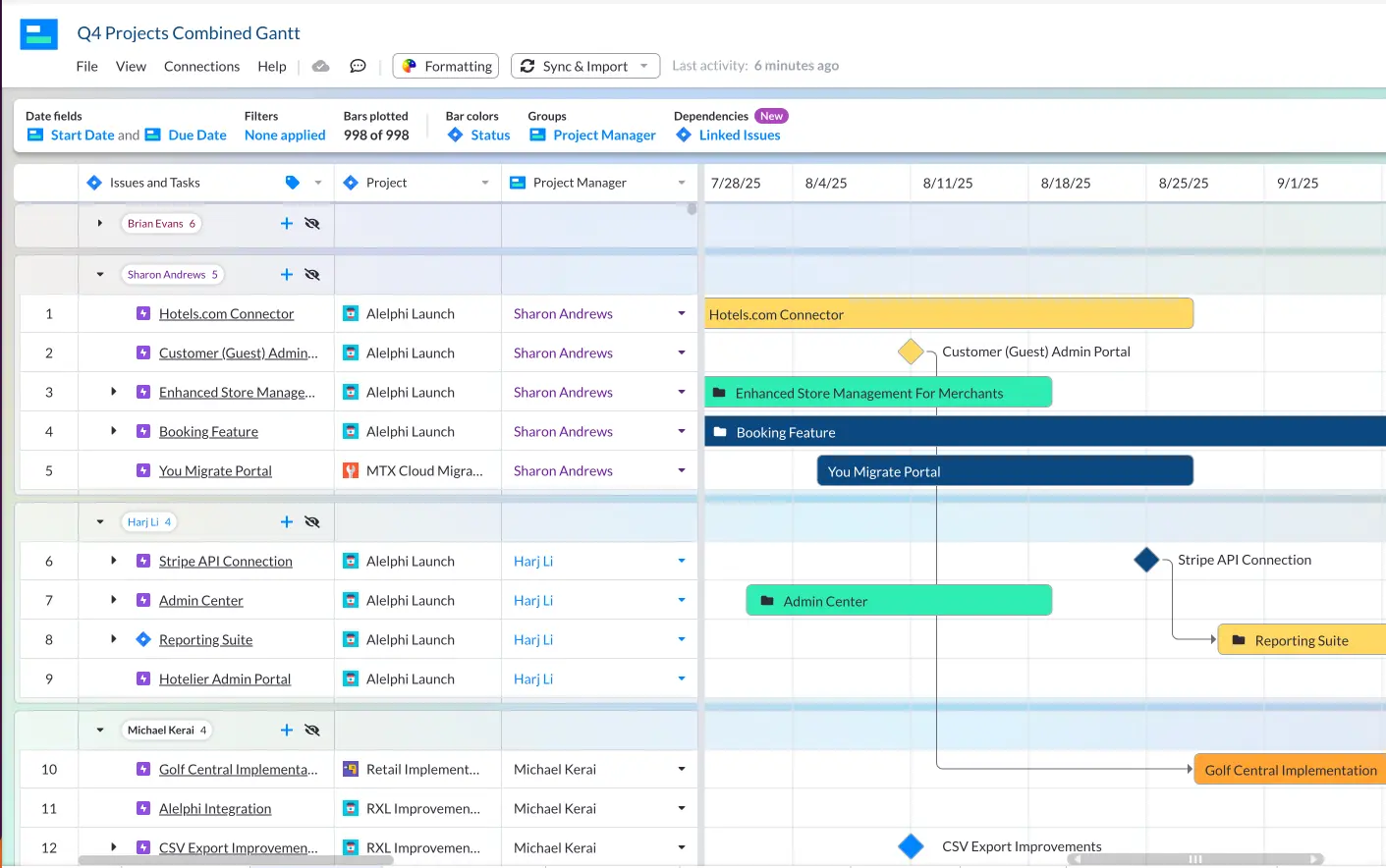
A project portfolio timeline I created in Visor’s Timeline view:
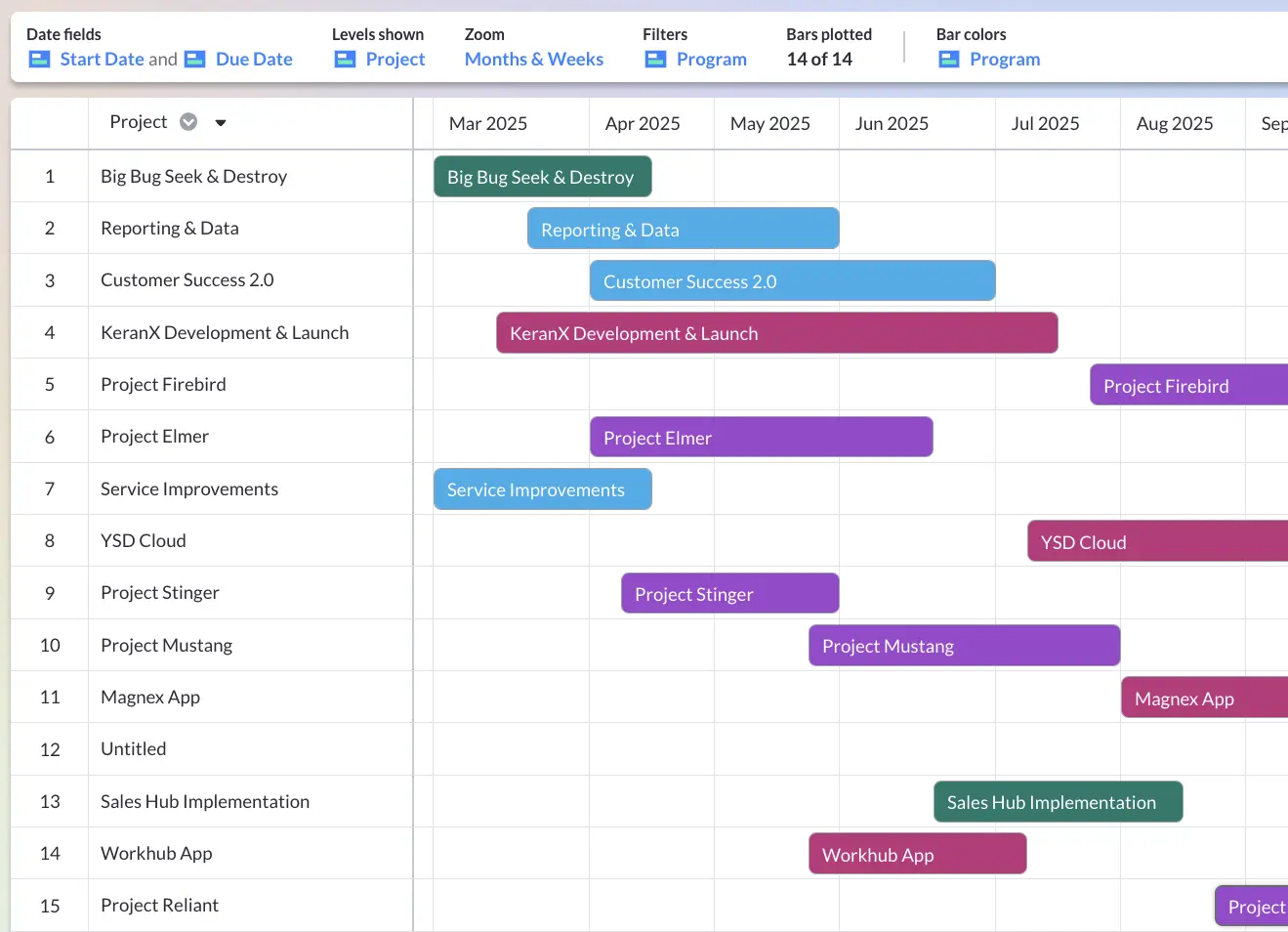
Also in Visor, a project portfolio management dashboard, to track key metrics across the portfolio and compare performance between projects in the portfolio:

Benefits of Project Portfolio Management
Here are the main benefits of using project portfolio management (PPM):
- Improves strategic alignment: Assessing and adjusting projects on the basis of their alignment with your strategic goals helps remove those projects or parts of projects that don’t help you achieve your strategic objectives.
- Reduces resource waste: Taking a portfolio view of projects enables you to monitor resource usage across projects at an organizational level, and relocate or share resources where it makes sense to do so. PPM also increases accountability for resources within the portfolio and in individual projects.
- Fosters shared learning: PPM at its best creates an environment for managers of projects within a portfolio to collaborate, share learnings, and offer support or solve problems together. This helps improve portfolio performance and create a system of support for your PMs.
- Standardization of project management: PPM introduces standardization over projects submission, selection, planning, management, and monitoring. When done right this means best practice can be implemented at every stage.
- Enables continuous improvement: Just as resources and best practices can be shared, so too can learnings of what went wrong, or could’ve gone better. These learnings can be used to adapt your PPM and standardized project management processes to prevent repeated mistakes and keep optimizing performance.
- Reduces risks: PPM assesses proposed projects for risks, and creates processes and strategies to mitigate risks before they arise. Having this combination of pre-project scrutiny, and a watchful eye over projects with the power and knowhow to take action when required, all helps reduce the risk of project failure.
- Increases accountability: PPM introduces structures and criteria for measuring project performance in a repeatable way. This enables easier comparisons between and across projects, and between project managers. This strips away the mystique that each project needs to be judged independently and enables objective performance monitoring across every project in a portfolio.
- Gives PMs a voice at the highest level: Project managers are often not the most listened to voices in an organization. Portfolio managers typically talk directly to the c-suite, and can be an advocate for project managers, and their ideas, concerns, and demands.
- Reduces project overruns: PPM introduces a role or department with direct oversight over project efficiency. If projects are in danger of overrunning, or overspending the portfolio manager can redistribute or reorganize resources to keep things on track. Or, if a project is more trouble than it is worth they have the power to step in and kill it at the right time, before it causes more damage.
- Enables scenario analysis: PPM creates a space where comparing a range of different projects to see what is going to be most effective in achieving organizational goals is essential. Outside of PPM this is an activity that project managers rarely engage in.
Best Practices For Project Portfolio Management
The best approaches to project portfolio management will vary based on your specific environment and objectives, but there are some fundamental best practices you should incorporate into your portfolio management processes to make them and your portfolio as effective as possible.
1. Engrain Root-Branch Strategic Alignment
Strategic goals should be engrained throughout your portfolio management processes, shaping everything from project selection to performance management and metrics.
This requires strategic goals that are clear, defined, and easily translatable into actions, metrics, and decisions. Strategic goals that are ambiguous can lead to inconsistencies or confusion in your processes and evaluation of project performance.
2. Implement and document clear portfolio governance structures
You should design and document clear structures and guidelines for decision-making processes and responsibilities within your project portfolio. You’ll find plenty of guidance online to help, so don’t feel the need to reinvent the wheel.
Portfolio governance structures will typically provide guidance or rules for:
- Roles, responsibilities, and the chain of command
- Processes for project identification and submission
- Processes for project selection or rejection
- Processes for project prioritization and resource allocation
- Key risk management and mitigation strategies
- Reporting and performance management
- Team/organizational structures
- Communications protocols
3. Balance Standardization With Flexibility
Introducing project portfolio management usually leads to greater standardization in project management processes, including how projects are proposed, planned, and reported on.
Greater standardization makes it easier to implement best practices, create portfolio timeline and capacity plans, measure portfolio level performance, and to make clear performance comparisons across projects.
However, you should avoid becoming too dogmatic, and imposing the same methodologies where they don’t fit. Instead always balance what is best for the performance of each project with what is best for the management of the portfolio. This can be tricky, but a good dose of common sense and adaptation can help you find a solution.
Portfolio Roadmap created in Visor with Jira Dependencies:
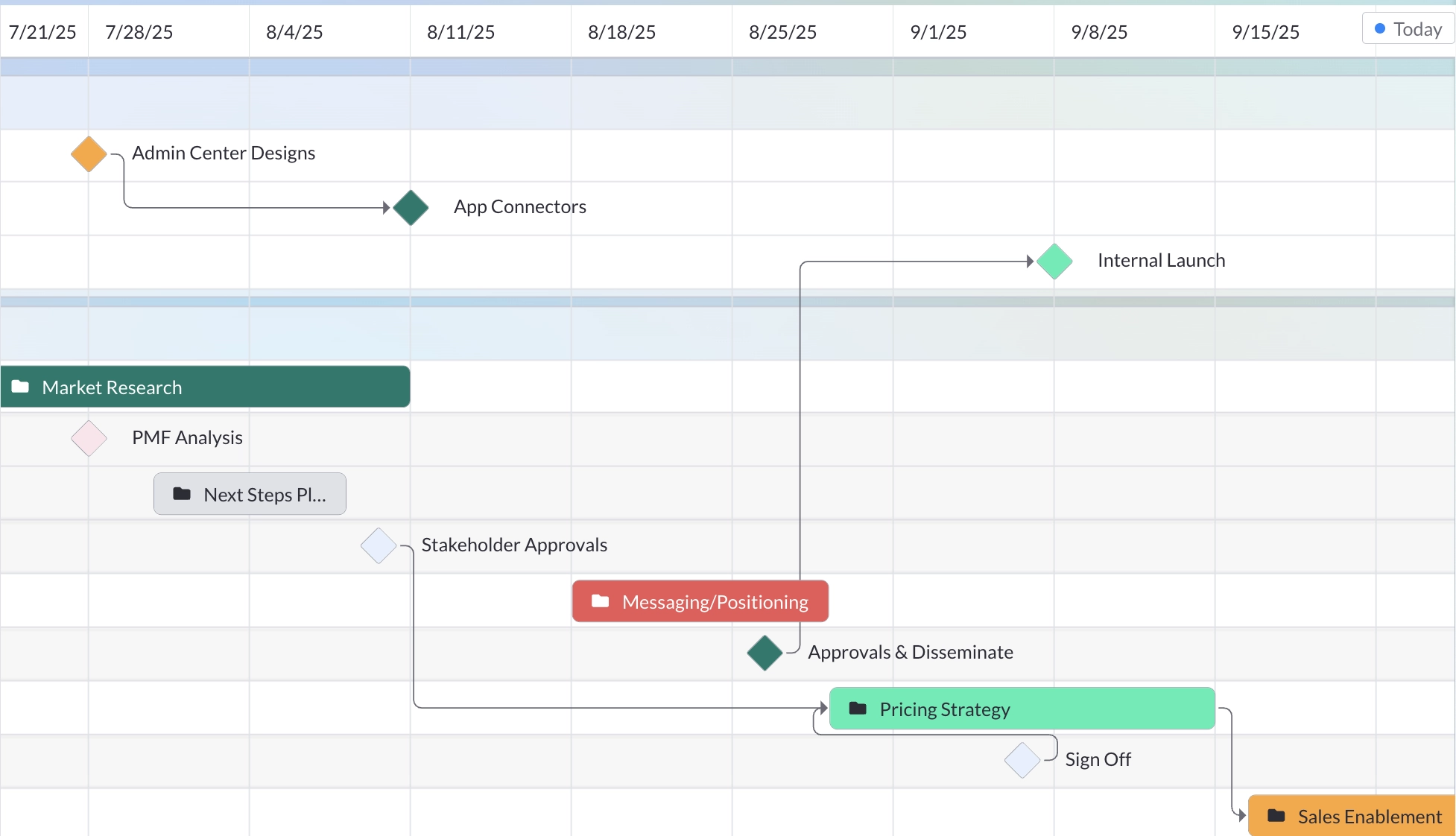
4. Review Your Portfolio Regularly
Effective management of your portfolio of projects requires a mix of scheduled and continuous monitoring of performance at both a portfolio and project level, which should include the following:
- In-depth reviews of your project portfolio at least once per quarter.
- Real-time monitoring of PPM KPIs and metrics using project portfolio dashboards
- Creating and implementing ad-hoc action plans
- Individual project reviews with project managers at least once per quarter
5. Portfolio Diversification
Similar to an investment portfolio, having a diverse range of project types in your portfolio can reduce risk and maximize reward. What this means in practice will depend on your specific organization and industry but will typically involve:
- Having a mix of high risk-return, moderate risk-return, and low risk-return projects
- Projects that focus on new customer acquisition vs. projects that improve retention
- Infrastructure projects and other initiatives focused on improving internal processes (e.g. recruitment, logistics, facilities, hosting, cybersecurity etc.)
- Speculative research and development vs. high-confidence development
Having clear governance structures, and processes for how projects are submitted and selected can help you categorize projects based on factors like risk, to help you clarify whether your portfolio is sufficiently diverse and balanced.
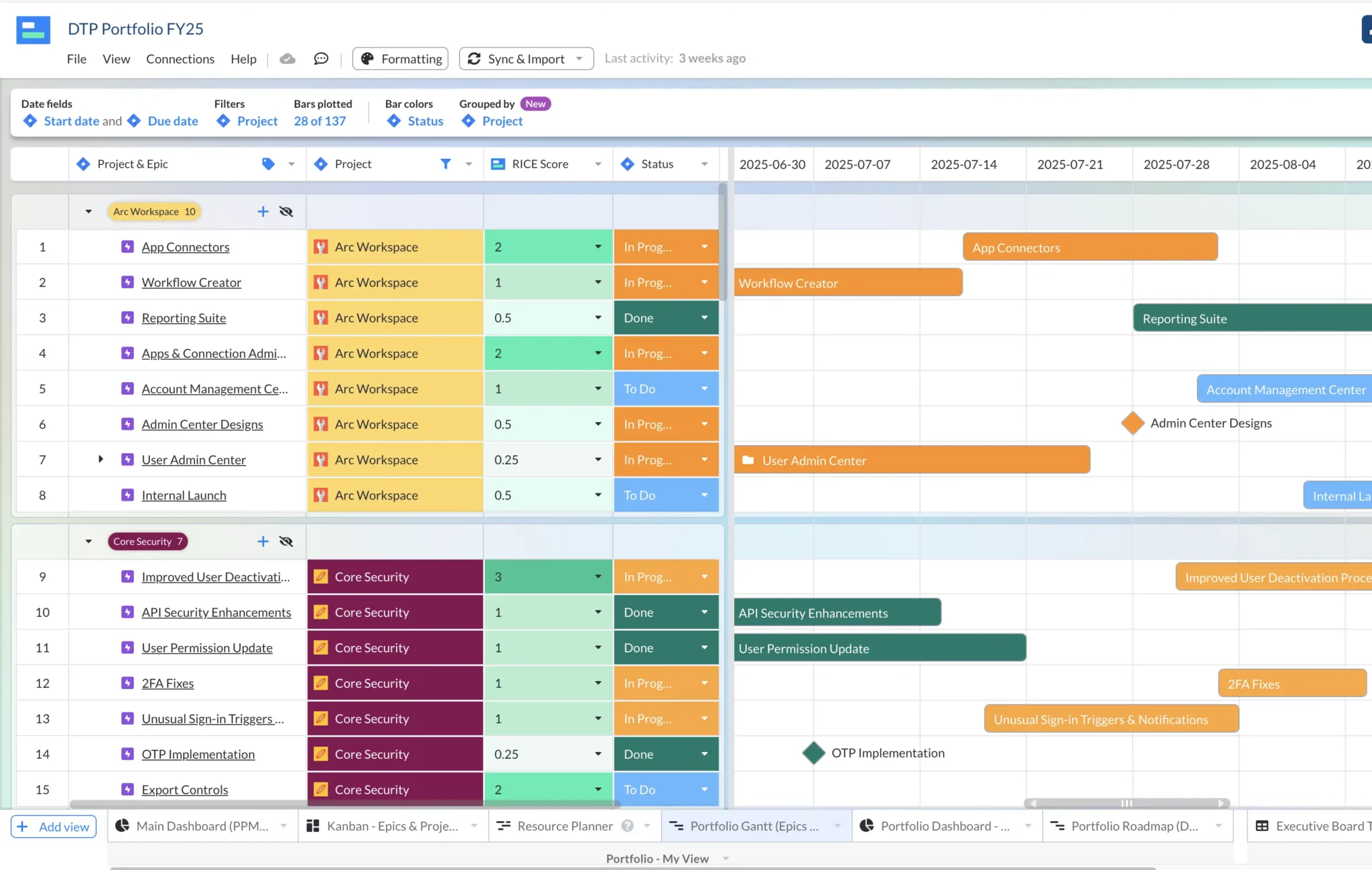
Visor offers Project Portfolio Management templates that make it easy to get started visualizing your portfolio.
6. Make resource optimization preventative, not just reactive
Teams in project portfolio management often make the mistake of only reallocating or increasing resources when something goes wrong and the portfolio begins to be at risk.
Instead, teams should use metrics and continuous monitoring to identify early-warning signs to address resourcing shortages, or performance problems that are leeching resources, before they become a serious issue requiring difficult fixes. PPM software can unlock a wide range of capabilities in this area.
Keeping open, honest, always-on communications with project teams can also help, by ensuring project managers feel empowered to proactively flag when they are concerned about resourcing in their projects.
7. Crystal clear communication and engagement with stakeholders
Keeping stakeholders informed and engaged is an important part of securing ongoing support for your project portfolio.
Your project management team needs to know how project intake processes work, what success at a project level looks like, and how they can best contribute to the overall success of the project portfolio too.
They also need to be continuously engaged with their own project’s performance and your perspective on it to ensure you are all aligned on project health and performance.
Your C-suite needs to have clarity over how the portfolio will enable the organization to achieve its strategic objectives, your timelines for doing so, and expected ROI. This will ensure they understand the why of your portfolio, and secure their buy-in, at the outset.
Securing this understanding and commitment now will pay dividends later if the portfolio faces challenges, or additional resources are required.
High-power, high-interest stakeholders should be kept updated (using real-time data where appropriate) on overall portfolio performance and high-level overviews of how different projects are progressing.
Communicating portfolio performance to all stakeholder types can be made much easier with the help of PPM software like Visor, which includes customizable visualizations like portfolio level Gantt charts and dashboards.
You can use Visor to create and share customized visualizations for different stakeholder types using real-time data from apps like Jira, Asana, and Salesforce.
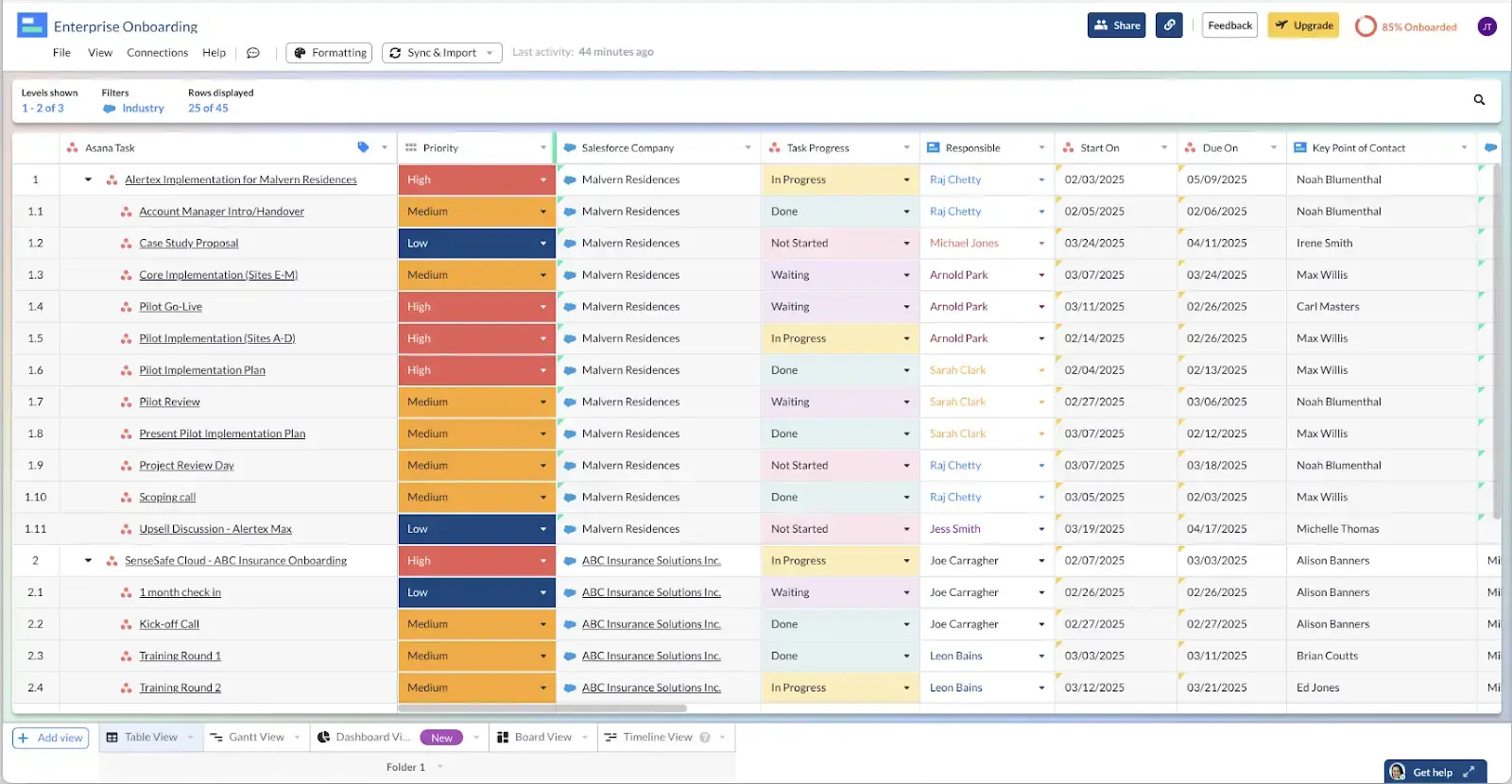
You can also use Visor to communicate externally to customers. Below is an enterprise onboarding visualization using numerous Asana projects and our template for onboarding new customers or Mutual Action Plan template.
8. Continuous improvement
Bringing projects together into a portfolio gives you a wellspring of learnings and data that you can use to continuously improve both project management and portfolio management processes.
Continuous improvement will not occur on its own. You need to set up processes to understand and document:
- What went badly, what could have gone better, and what went well
- The reasons why
- What you could do differently next time to improve
- What actions need to be taken to ensure those improvements are made and sustained
As in any part of an organization, continuous improvement requires a learning culture (rather than a blame culture) and a growth mindset.
Project Portfolio Management Process – Key Components
A wide range of project portfolio management process frameworks have been developed, with many of them documented in journals and conference papers issued by organizations like the Project Management Institute.
The best framework to build your project portfolio management process will depend on a range of factors, but all robust project portfolio management processes will always include these key steps:
- Define Your Organization’s Strategic Goals
- Understand Your Organization’s Resources
- Codify Your Project Evaluation and Prioritization Criteria
- Create a Project Intake Process
- Evaluate, Select, and Prioritize Projects
- Schedule Projects and Resources Optimally
- Develop a Risk Management Strategy
- Secure Stakeholder Buy-In
- Track and monitor project and portfolio progress and performance
Below I’ve explained how to best approach each of these steps.
- Define Your Organization’s Strategic Goals
You can’t align projects with strategic goals or objectives if you are unsure what those goals are.
Ensure that your organization has clear and documented strategic goals, these should ideally have a measurable target and a date you aim to reach it by (such as percent market share by June 2026, or annual recurring revenue of $3M by December 2027).
Your organization’s strategic goals will steer the projects you select for your portfolio, their prioritization, and the level of resource you commit to them, so it is vital they are chosen correctly.
- Create a Project Intake Process
Create workflows for how projects should be submitted, evaluated, and selected. This should also be documented in your portfolio governance documents. The documentation should clarify:
- How projects should be submitted (format, information requirements, timelines, etc.)
- Who is responsible for evaluating, approving/rejecting, prioritizing, and scheduling projects
- The process and timelines for this process (from intake to decision and prioritization)
The project evaluation and prioritization criteria should include:
- Strategic alignment
- Strategic importance
- Budget and resource demands vs. capacity and availability
- Expected tangible and intangible returns (ROI or NPV) and impact/benefits
- Overlapping objectives and/or resource demands with other proposed/active projects
- Risk profile
You should expect to capture these details in the project submission (whether using a form or another format) so that you can evaluate the project fully.
- Evaluate, Select, and Prioritize Projects
Using the criteria you defined in Step 4, you can employ different project scoring methods to help you both evaluate and rank your projects. Examples of project scoring methods include:
- Simple Scoring: Each project is given a score for each of the criteria from Step 4 above and a total score based on the sum of all the scores for each criterion.
- Weighted Scoring: The same as Simple Scoring, except each criterion is given a weighting based on how important the organization feels it is.
- Payback Period: Focuses on prioritization projects based on the likelihood of return, the amount of return, and the time it takes to get a return.
- Value vs. Complexity: Each project is assigned a level of expected value and expected complexity (or effort and resources it will require). Projects are usually then plotted on a four-quadrant matrix (example I created below):
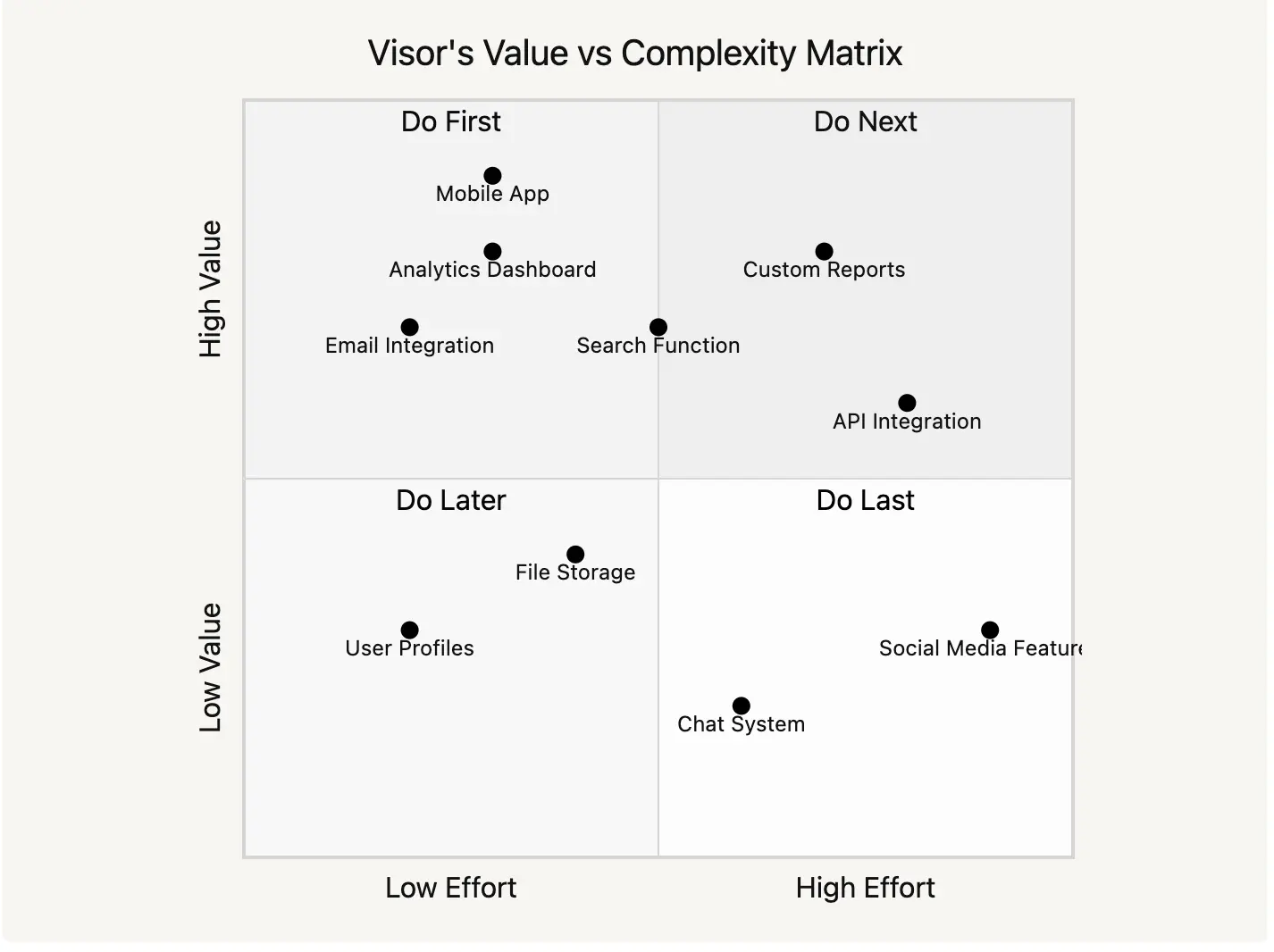
- Do First (Q1): High value, low effort – Quick wins with immediate impact
- Do Next (Q2): High value, high effort – Critical strategic initiatives
- Do Later (Q3): Low value, low effort – Nice-to-have features
- Do Last (Q4): Low value, high effort – Avoid or postpone these items
- Schedule Projects and Resources Optimally
Once you have prioritized your projects you can start scheduling them and allocating resources accordingly.
In advanced PPM setups, you may use a competency matrix and software to support resource optimization.
If you don’t require that level of complexity you can create timelines based on estimates of how long each project will take to complete, or use critical path scheduling to get a reasonable estimate of how long the project will take to complete.
When you’re creating these timelines you need to consider competing demands for the same resources and personnel.
It’s best to focus on the most critical resources rather than trying to plan out each individual’s time and it’s usually sufficient to take a month by month view of capacity and resource utilization.
A simple capacity planning chart I created using Visor’s Timeline view, showing projects in my portfolio and resources committed to them:
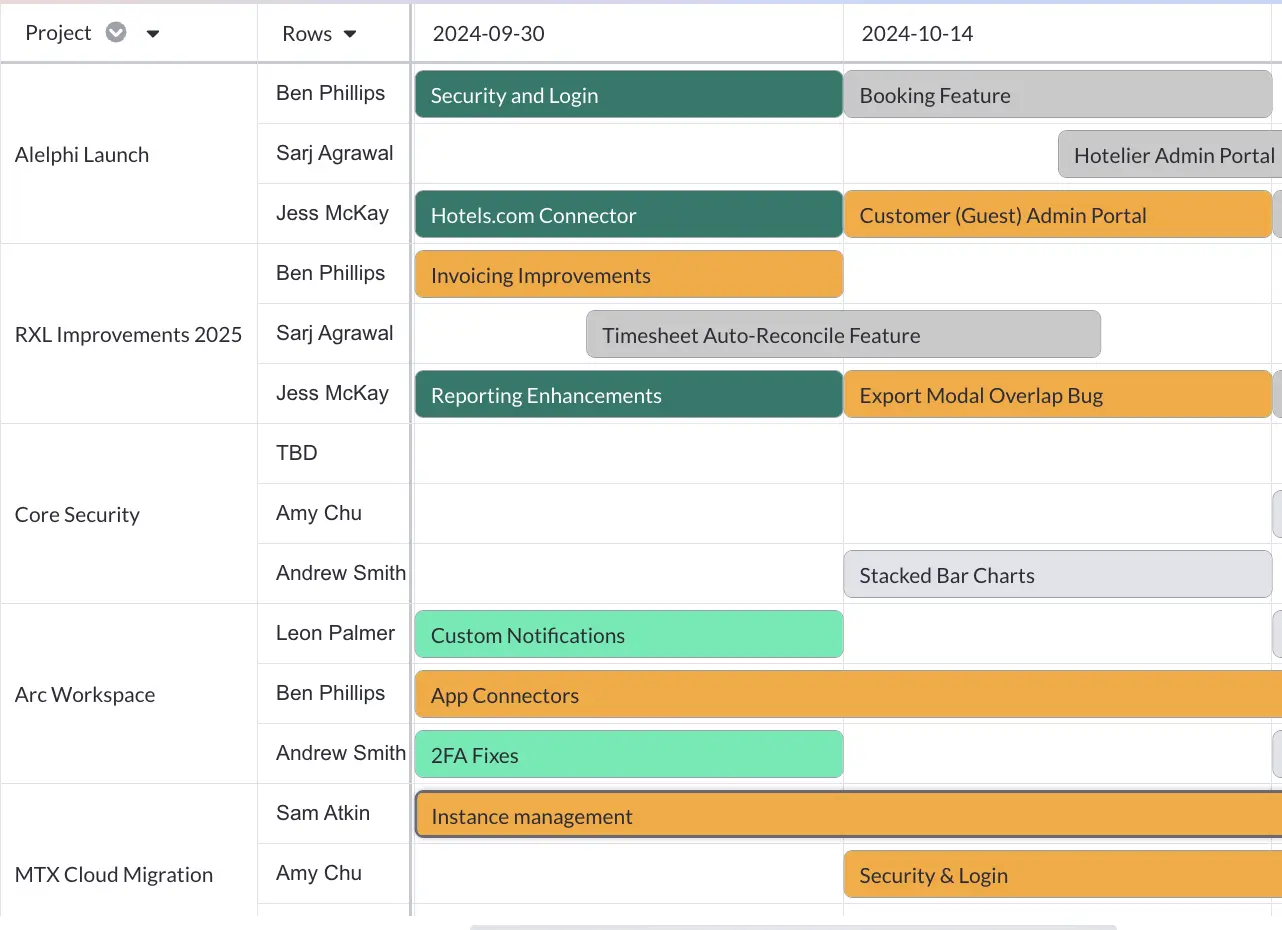
- Secure Stakeholder Buy-In
Once you have assembled your plan you need to ensure you have buy-in from different stakeholders, typically your c-suite, but also your project managers and/or program managers.
To do this you need to share and present plans that are clear and compelling, and provide the right level of detail and data points for each stakeholder group.
Visor makes it easy to create crystal clear project portfolio visualizations using real-time data. Using Visor you can create and share custom views for different stakeholders, with the level of detail and real-time data that they need.
Whatever tool you use to share and show your plans, ensure you are communicating how:
- Selected projects are aligned with your strategic goals
- Resources are balanced to maximize efficiency and prevent delays
- Risks have been considered, and appropriate risk management strategies have been put in place
- The portfolio is balanced, with a healthy mix of project types and risk profiles
- Track and monitor project and portfolio progress and performance
Once projects in the portfolio are in progress you will want robust mechanisms to track the performance of the portfolio, and high-level project-to-project performance metrics.
These will vary according to the size of your project portfolio, your industry, and how you determine success. Metrics will typically fit into these areas:
- Project Completion: What percentage of projects in the portfolio are at each completion stage
- Project Execution/Quality: What percentage of projects are late, have been approved by stakeholders or clients, are over budget, and were delivered on time? These metrics can be measured at both a portfolio and a project-project level to identify which projects have the biggest problems.
- Resource utilization: Measurements of overall utilization of budgets and personnel, both at a portfolio and a project level. Useful for identifying where resources are most needed, not being used efficiently, or if surplus to requirements can be shared with other projects.
Tracking PPM metrics is most effective using dashboards that bring together live data from all the projects in your portfolio. This will give you the most accurate, up to date data, to help you make better judgement calls more often.
Most project management tools don’t offer portfolio level dashboards and other visualization types (like Gantt charts and timelines). Or if they do they are packaged as expensive, enterprise level upgrades.
Many PPM tools integrate with project management software to create these dashboards and visualizations, but most PPM tools are very expensive, complex, and difficult to use.
Visor makes PPM easy. It is used by teams and organizations of all sizes and has two-way integrations with apps like Jira, Asana, and Salesforce, so you can easily create real-time portfolio dashboards and other visualizations.
A PPM Gantt chart I created in Visor using real-time Jira data:
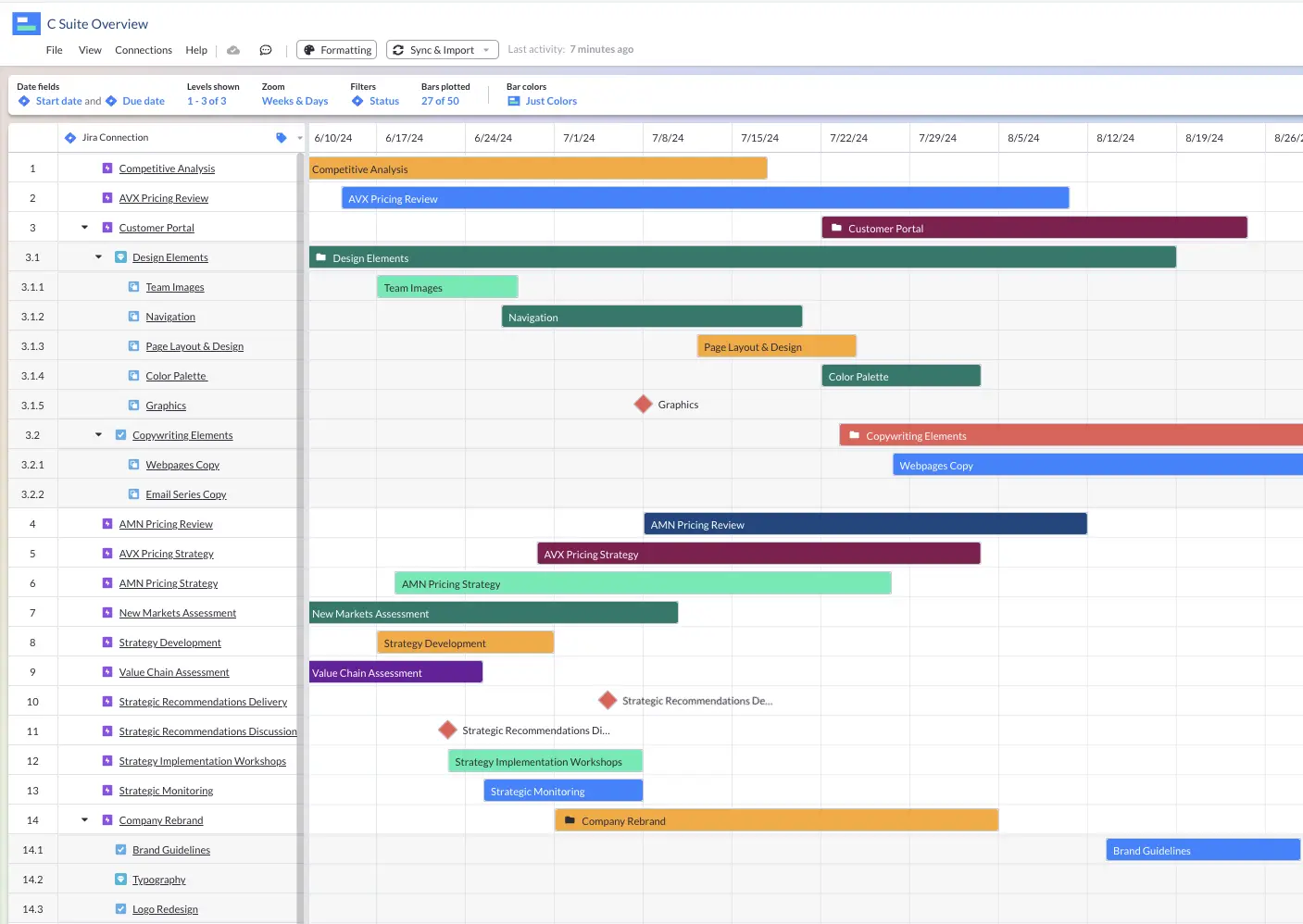
Project Portfolio Management – Your Next Steps
Even if your organization and number of projects are relatively small, project portfolio management can positively transform your approach to project management.
PPM can help you to understand and improve project performance. It can help ensure you have resources where they are needed most, or where they will deliver the maximum ROI and support your strategic goals.
For any organization to extract the maximum benefit from PPM it needs to find an approach that fits with its size, capabilities, and goals. There is no need for a small to mid size organization to have the same levels of procedural complexity as a large organization with multiple divisions.
Instead you need to take the principles of PPM and craft processes that work for you. This guide should help you to do that, to create a PPM process that fits your organization and rivet it with tried and tested PPM best practices.
Regardless of your size, industry, or PPM processes, you’ll also need tools to help you manage and monitor your portfolio of projects. Visor is a modern, flexible PPM tool that is used by organizations of all sizes, from small startups to large enterprises and government agencies.
A portfolio of projects and their Jira epics in Visor’s Table view:

With Visor you can easily create portfolio plans and visualizations that enable you to:
- Take control over your portfolio of projects
- Align stakeholders behind your shared objectives
- Understand portfolio and project performance from any angle
- See both the big picture and the necessary detail whenever you need it
Try Visor completely free now and see how it can make PPM easy for you and your team.



